Analysis of automotive plug-in fuse wiring harness
I. Structural design and core functions
Plug-in fuse assembly
It consists of a fuse, a plug-in terminal and a sheath. The fuse is made of alloy material and realizes circuit overload protection through precise fusing characteristics.
Chery’s patented sheath (CN 222706163 U) protects the plug rod through the inner tube design, prevents the needle from bending and supports the correction function.
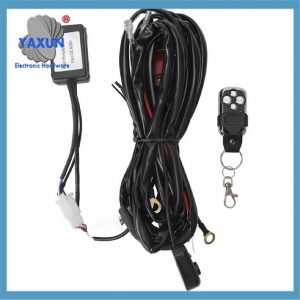 Custom LED Lights Bar Remote Control Wiring Harness Kit 4 Leads DC12V On-Off Switch Power Relay Blade Fuse 14AWG Core Cable |
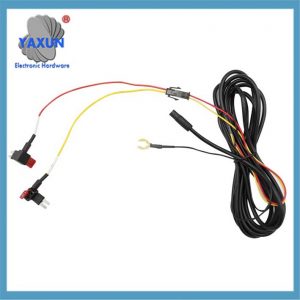 Fuse Box Cable Hardwire Kit, 4 In 1 ATO (Regular), Mini, Micro, Low-Profile Mini wiring harnesses |
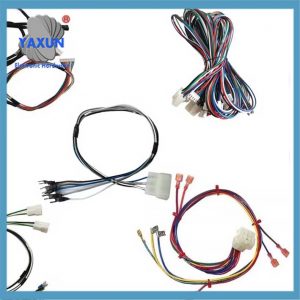 Automotive Atc Blade Fuse Holder Middle, Mini Electric Car Wire Harness Fuse Holder |
Wire harness connection parts
Includes zinc alloy plug-in terminals, high-temperature silicone wires and waterproof fuse boxes to ensure low contact resistance and high temperature resistance.
Some wiring harnesses integrate ISO standard plugs and are compatible with different car model interfaces, such as special adapters for brands such as Volkswagen and Toyota.
II. Parameter selection and adaptability
Current and specification classification
The current range covers 1A-120A, and the color identification is clear (such as 10A red, 30A green, 100A purple). Mainstream models include MINI (1A-40A), ATO standard (5A-40A), and MAXI (20A-100A). AMT large fuse (20A-120A) is required for high current scenarios.
Application scenario adaptation
MINI is used for compact spaces (such as dashboards), and MAXI or double fuse structure is used for high power equipment (such as inverters).
Audi, Volkswagen and other models need to match special fuse boxes, such as Audi Q5L is suitable for medium 20A fuse.
3. Installation and maintenance points
Wiring specifications
Use a multimeter to detect continuity to avoid reverse connection of positive and negative poles and burn the equipment; signal lines (such as CAN bus) need to be connected according to color.
Waterproof fuse boxes (such as BH-709S) need to ensure sealing to prevent short circuits in humid environments.
Troubleshooting and replacement
Frequent fuses need to check whether the equipment power is overloaded, and fuses with original color identification are preferred.
The skew of the plug rod can be corrected by the inner tube of the sheath. If it is severely deformed, the entire set of connectors needs to be replaced.
V. Technology development trend
Integrated protection: The sheath design develops towards modularization, such as Chery’s patented sheath compatible with correction and multiple protection functions, reducing manual intervention1.
Large current support: Large fuses such as AMT improve the current carrying capacity of more than 120A by optimizing materials (such as PC+zinc alloy).
The above information combines patents, technical standards and market hot-selling product parameters, which can provide a reference for selection, installation and troubleshooting.
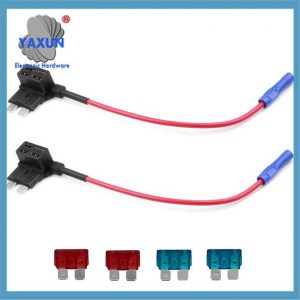 Car Truck 16 Gauge Add-a-circuit Fuse TAP Adapter for Regular Standard Blade Type Fuse |
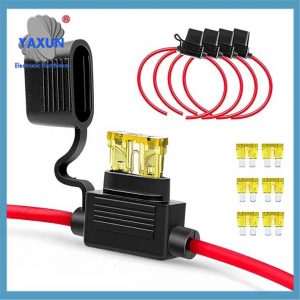 Inline Holder 14AWG Wiring Harness with ATC, ATO 30Amp Blade Automotive Fuse Holder |
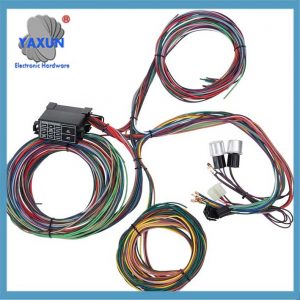 12-Circuit Mini-Fuse Wiring Harness Kit- Perfect for DIY Builders, Custom Vehicles, Restorations |
Automotive fuses are often called blade fuse. The matching design of fuses is an important part of the overall vehicle principle design. It includes the selection of fuse type, capacity selection, fuse path setting, fuse sharing, usw.
1 – How the fuse works
Understanding the working mechanism of fuses is the prerequisite for correct fuse matching design. To fully understand the working mechanism of fuses, you only need to understand two questions:
1. Why do we need to add a fuse to the circuit?
2. How the fuse protects the circuit.
Why do we need to add a fuse to the circuit?
If there is no fuse in the circuit, once the circuit is overloaded or a short circuit occurs, the current in the circuit will inevitably increase. In this way, when the current flowing through the wire exceeds the carrying current of the wire, the wire will be overloaded and heat, melting the insulation layer and copper wire of the wire, or even spontaneous combustion, causing a safety accident.
Such a component that protects wires in a circuit is what we call a fuse, or fuse. A fuse is a thermal fuse device. It is intentionally designed and manufactured to be the weakest part of the line in order to protect the wiring harness. It is an electrical component that protects wires and electrical appliances. It is worth mentioning that in the circuit, the fuse can only protect the wires after the fuse, so the fuse should be set as close to the power supply as possible, as shown in the figure below. If the distance is too far, you need to consider setting up higher-level insurance.
The working principle of the fuse is to blow the wire in time when the circuit is short-circuited and the wire smokes and catches fire. In order to cut off the circuit and prevent the wire from burning and causing the entire vehicle to spontaneously ignite.
The specific working principle of the fuse is as follows:
Fuses have a certain resistance and the conductors heat up when current flows through them. As time increases, the amount of heat generated increases, and the current and resistance also increase the rate of heat generation. The construction of the fuse and its installation determine the rate of heat dissipation.
If: heat generation speed < heat dissipation speed, the fuse will not blow;
If: heat generation speed = heat dissipation speed, it will not fuse for a long time;
If: heat generation speed > heat dissipation speed, heat will accumulate, and when the temperature rise reaches above the melting point of the fuse, the fuse will blow.
Introduction to the categories of fuses:
According to the appearance characteristics of fuses, they can be divided into:
Bladefuses. It consists of two blade-shaped plug-type input and output terminals, an electrical conductor composed of a fuse, and an insulator component. Also called plug-type, blade-type, blade-type fuses. Common models include AUTO, FKS, MINI, FK1, MAXI, FK3, and LP-MINI.
Cartridgefuses. It is composed of an electrical conductor component composed of two blade-shaped socket-type input and output terminals and a fuse, and a combined insulator component. Also called socket fuses and box fuses. Such as JCASE, LP-JCASE, MCASE.
Boltdownfuses. It consists of two blade-shaped plug-type input and output terminals suitable for screw connection, an electrical conductor component composed of a fuse, and a combined insulator component. Also called bolt-on fuses. Such as MIDI/BF1, MEGA.
Commonly used fuses in cars mainly include: Mega, Mini, Midi, and JCASE.
According to the blowing characteristics of fuses, they can be divided into:
Fast-blow type: suitable for small current and short-time pulse current loads.
Slow-blow type: suitable for large current and long-term pulse current loads.
 English
English العربية
العربية Български
Български Čeština
Čeština Dansk
Dansk Nederlands
Nederlands Suomi
Suomi Français
Français Deutsch
Deutsch Magyar
Magyar Italiano
Italiano 日本語
日本語 한국어
한국어 Português
Português Română
Română Русский
Русский Slovenščina
Slovenščina Español
Español Svenska
Svenska Tiếng Việt
Tiếng Việt
